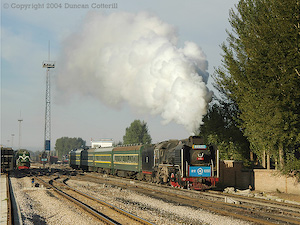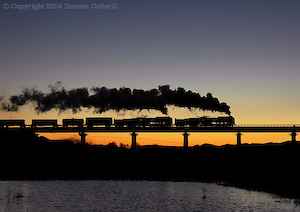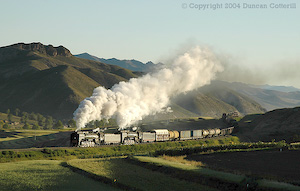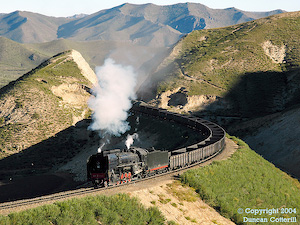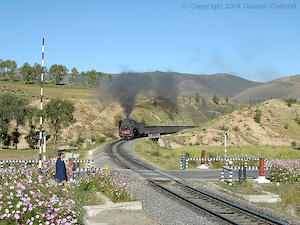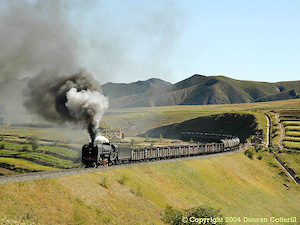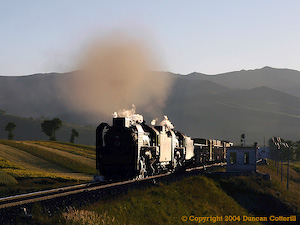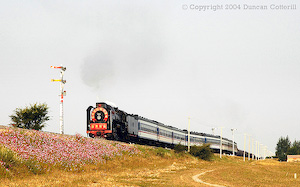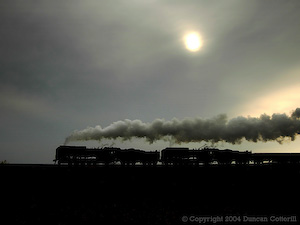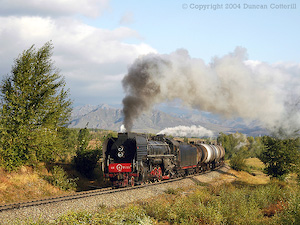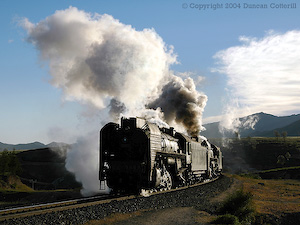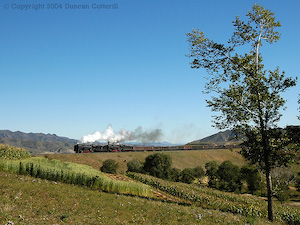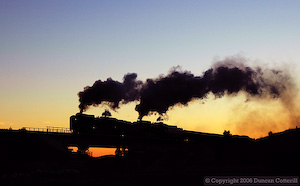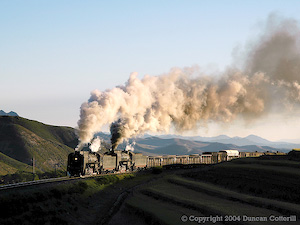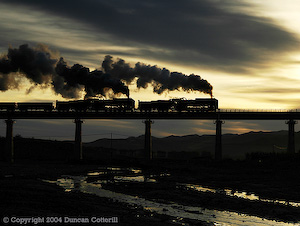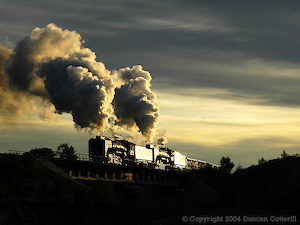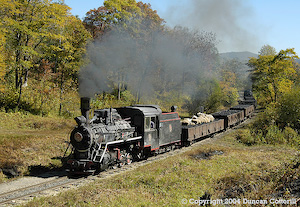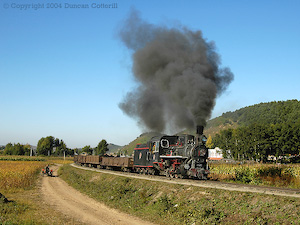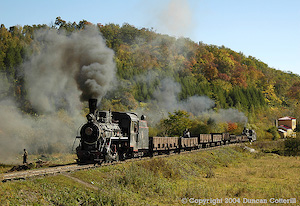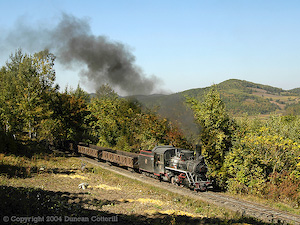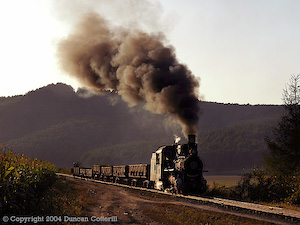Autumn on the JiTong Railway
07 - 25 September 2004
Report by Duncan Cotterill
Introduction
Following on from our late Summer / Autumn visits to Ji-Tong in 2002 and 2003, a return trip was inevitable. The potential is just so great at this time of year, even if it’s rather difficult to translate into actual pictures. In contrast to the previous year’s trip when there were just two of us, we were a party of eight this time; Jim Livesey, Peter Breeze, Richard Lewis, Bryan Acford, Robert Horlacher, Mike Dodd, Chris Smith and me.
Huanan had been on the agenda for several years but had never come off, principally due to the system’s prolonged shutdowns lasting several weeks after the spring festival. This always coincided with the time we were in northern Manchuria, visiting the narrow gauge forestry operations at Yabuli, Weihe and Zhanhe. Following Rob Dickinson’s successful trip last October, we decided to try a September visit. This was a good decision.
As usual, arrangements were made through Sun Xiaolan of China Liaoning Steam Locomotive Photography Association (CLSLPA) and Xiaolan accompanied us as guide throughout.
Beijing to Chifeng
(07-08 September 2004)After meeting with Xiaolan at Beijing Airport, we travelled into town for a meal and then on to Beijing Nan station for train 2189, the 15:13 to Wulanhaote, which would take us to Chifeng. Our locomotive was an unidentified green DF4 for the section to Longhua. Passing the loco depot outside Beijing main station, a number of SS9G, DF11 and DF11G were seen. There was only one BJ, half of a double unit, and a single NY7, number 0015. The BJ was the only one we saw in the entire Beijing area, a sign of the demise of this once numerous class. DF8Bs predominated on freight around the Beijing area with DF4s, including some DF4As, handling the remaining freights and the passenger trains. We had expected to be routed via Chengde but instead took the more northerly route direct from the Miyun area to Longhua. This is a superbly scenic line through a verdant green mountain landscape with numerous bridges, tunnels and high embankments. Freight traffic was relatively heavy for a single track line with trains hauled by a mixture of DF4s and DF8Bs. Some trains were double headed by one of each class. The passengers were all DF4 hauled. North of Longhua, a few Chifeng based DF4C were seen on freight but no passenger trains were observed. Arrival at Chifeng was on time at 00:50.
Yuanbaoshan Mine Railway
(08 September 2004)We left Chifeng just before 06:00, arriving at Xizhan (Yuanbaoshan) in good time to see the 07:00 passenger leave behind JS 8250. JS 6245, 6544 and 8246 were also seen in use. JS 6544 is an interesting locomotive. It has the single slidebar arrangement found on JS ‘B’ type locos (JS 8xxx series) and a 1987 builders plate. Could this be the prototype JS ‘B’? Yuanbaoshan Power Station’s GKD1 4009 was seen tripping between the power station and Xizhan. Leaving Yuanbaoshan around 09:30, we travelled by road to Reshui, arriving in time for the afternoon photographic session.
JiTong Railway – Jingpeng Pass
(08 – 12 & 15 - 19 September 2004)Jingpeng was magnificent as always. I thought the pass had been very green last September but it was even better this year. The harvest was running a good 2 – 3 weeks later so there were more crops in the fields resulting in more colourful settings for our photographs. As usual, it was hard work to find places where the wind, light and smoke all worked at the same time and we had many failures. However, when everything did work, the results were memorable. No diesels were seen apart from the Hohhot – Tongliao passenger trains which were running daily in both directions.
Train timings and frequencies varied considerably from day to day and there were some long gaps when nothing ran but, on the whole, traffic appeared to be heavier than last year. The biggest difference noted was the large volume of empty oil tanks heading west, sometimes as block trains numbered in the 84xxx series and sometimes marshalled into general freights. Eastbound coal traffic was also heavy. As a result, there were very few light engine moves and more westbound single headers than usual.
The weather was fairly kind to us with less in the way of cloud than last year. There were several hazy days but also a few that were crystal clear from start to finish. Temperatures dropped to near freezing around dawn on several days but usually rose to the mid/high twenties during the afternoon. White exhausts were rare after about 09:00 and sometimes disappeared just after sunrise. Towards the end of our stay, a strong north-westerly wind blew almost continuously for several days, just like in winter but nothing like as cold.
The road from Linxi to Reshui has been resurfaced all the way and the river bridge replacement between Reshui and Yuzhoudi is complete. This makes chasing much easier on this section but that may soon be irrelevant as a new line of poles is being erected along the south side of the line, close to the track, ruining most of the photo positions east of Gala. Over the pass the poles aren’t a problem as they take a direct route between stations rather than following the twists and turns of the railway. The Reshui bypass is also complete and work is underway to resurface the main street of Reshui and the connecting roads to the bypass. The new highway is said to be complete, although not officially open, from Jingpeng to where it crosses the Chifeng – Linxi road. Vehicles are using it already, resulting in a reduction in road traffic over the pass, again assisting movement between photspots. West of Jingpeng, the new road gives access to the line towards Majiazi and Haoluku.
The Mafia are still active but it seems they have lost the support of the local government and police. They came to our hotel one evening but our guide stood up to them and we refused to pay. We didn’t see them again. If everybody stops paying, they should soon realise they’re wasting their time and give up.
Locos seen Daban – Haoluku:
QJ 6630, 6631, 6735, 6751, 6763, 6773, 6808, 6850, 6851, 6876, 6882, 6905, 6925, 6984, 6981, 6991, 7002, 7007, 7009, 7012, 7030, 7038, 7040, 7041, 7063, 7112, 7137, 7143, 7163.
JiTong Railway – Daban to Chabuga
(12 - 15 September 2004)Although a number of DF4s are now working from Daban to Chabuga, we didn’t see much of them during our stay here. Most trains were steam, often double headed with only one diesel working seen each day. Traffic was not heavy and levels and timings varied considerably from day to day. There were always more eastbounds than westbounds in daylight. The stopping passengers were steam worked by regular locos QJ 6911 & QJ 7010.
There were major roadworks in the vicinity of Yamenmiao which made chasing from one side to the other virtually impossible. As an example, we photographed the westbound passenger near Chabuga one afternoon then headed west for a second shot. Passing Daojiaduan, we were 10 minutes in front of the train and getting further ahead all the time. When we hit the first roadworks, we must have had an advantage of at least 15 minutes. By the time we passed Yamenmiao station, the train was just arriving.
On the other hand, access to locations on the climb from Lindong to the summit beyond Chaganhada is much easier than before. A paved road leads from the west end of Lindong to the new expressway, which is now largely complete. These two roads run close to the line in many places allowing phots at a number of reasonable locations that have been difficult to access in the past. Although the road is not officially open yet, we were able to use it between Daban and Lindong. West of Chaganhada, it is remote from the railway.
The weather was not kind to us here. We had two sunny days to start with but it was too hot, the light was very hazy and visibility was poor. The third day was cloudy with temperatures dropping steadily through the afternoon. It started to rain overnight and continued through the final day.
Locos seen Daban - Chabuga:
QJ 6729, 6849, 6850, 6853, 6884, 6911, 7010, 7037, 7048, 7081, 7105, 7119, 7163, DF4 0570, 0636
Daban Depot (09:15 15 Sep) – a very quick visit in the rain en route to Reshui. Not a complete list - just what we saw from inside the van.
QJ 6851, 6876, 6882, 6905, 7009, 7012, 7049, 7081, 7112, 7119, 7163 all in steam.
QJ 6385, 6576, 6577, 6580, 6795, 6926 dumped but largely intact.
Galadesitai to Huanan
(19 – 20 September 2004)It was difficult to find an efficient way of travelling from the JiTong line to Huanan. Most of the options would have cost us more than a day’s photting. In the end, we took the diesel unit to Tongliao, then a fast train to Siping connecting into the morning Shenyang – Harbin service. The connection into the last onward train to Jiamusi was too tight to be reliable so we completed our journey by road.
We had assumed that it would be easy to get sleepers on the unit but there were none available and we had to spend the night in the soft seat coach. At least we had room to stretch out and managed some sleep. Highlight of the journey was seeing an ex-works QJ 6828 at Zhelimu on it’s way back to Daban behind DF4 0398. DF4 0668 was also seen at Zhelimu. Arrival at Tongliao was on time at 05:28, leaving time for breakfast before the trek continued.
From Tongliao, we got soft seats on train 4228, the 07:00 Tongliao – Dalian, to Siping hauled by DF4 2425 (TL). Locos seen around Tongliao included DF4D 0308, 0369, DF4 1096, 1100, 1364, 2305 (TL), 2439 (TL), 7371, 7422. Pilots were DF5. No DFH3 were seen here or elsewhere in Shenyang Bureau. DF4 0352 (TL), 1493, 1651 (BC), 3314, 6084 (TL), 6154 were seen en route to Siping. About an hour out of Tongliao we passed a working narrow gauge sand railway where a primitive diesel loco was seen unloading a rake of wagons. The location is uncertain but it was west of Zhengjiatun. Arrival at Siping was on time at 09:46 giving a comfortable 28 minute connection into our next train, 2509, the morning Shenyang – Harbin fast, hauled by SS9 0033. (TL = Tongliao, BC = Baicheng)
Around Siping, DF4 1066, 1322, 1500, 1670, 2436, 3988, 6090, 7388 were seen. Pilots were DF7C including DF7C 5361. On the main line, most freights were SS4G hauled while passengers had SS9s of both the original and more stylish SS9G varieties. SS4G 0616, 0658, 0666, DF4 3877, 7458 were all noted before Changchun.
A GK1C was shunting at Changchun Nan (Mengjiatun) but there was no sign of the SYs seen here previously. DF4D 0045 (JL), 0098 (JL), 0100, DF4 1061, 4157, 6086 (CC), 7163, 7406 (CC), 7467 (CC), DF5 1358, DF7 5223, 5224, 5225, SS4G 0743 (HB), 7041, 7043, SS9 0012 (SY), SS9G 0112, 0118 were all seen around the Changchun area. DF4 1768 (CC), DF7 5356, DFH3 0242, SS4 0612, 0626 were at, or near, Tailaizhao. DF4C 5140, DF4 2182, 2307, 7325, DF4D 3086 were seen near to Harbin. We arrived about 10 minutes late, justifying the decision not to risk the connection into the Jiamusi train. (JL = Jilin, CC = Changchun, HB = Harbin, SY = Shenyang)
The road journey to Huanan was a nightmare. Our driver took a very roundabout route out of town to the expressway, which turned out to be a half built dual carriageway road with a terrible surface and more than it’s share of suicidal drivers. The direct road from Yilan to Huanan was closed for rebuilding and we had to go via Jiamusi where our driver got lost and managed to get back onto the northbound carriageway of the expressway we’d just left, heading south! A few scary moments ensued before we found the right road. Eventually, we got to Huanan about 22:00, totally exhausted. We had expected a frontier settlement like Zhanhe, with poor facilities, but were surprised to find Huanan was a large modern town with a good hotel.
Huanan Coal Railway
(21 – 24 September 2004)We hit Huanan at just the right time. For the first three days there was hardly a cloud in the sky, the trees were starting to turn golden and the trains ran reliably. The fourth day was cloudier with few trains but by then it didn’t matter so much.
The method of operation was different to that described in earlier reports. Long trains were worked between Huanan and Xiahua where they were divided and worked over the hill in two sections. On the return journey trains were combined at Xiahua for the run back to Huanan. When things were running smoothly there was a train from Huanan every eight hours or so, resulting in trains passing the summit around every four hours in each direction. Times varied from day to day but the pattern was the same. Once you found your first train, all the others were easy to predict.
Each loco and crew worked a complex diagram taking around 18 hours to complete; Huanan (16 empties) Xiahua (8 empties) Lixin (banker) Summit (light) Lixin (8 empties) Hongguang (8 loads) Lixin (banker) Summit (light) Lixin (8 empties) Hongguang (8 loads) Xiahua (8 empties) Lixin (8 loads) Xiahua (16 loads) Huanan.
We travelled by road from Huanan to Tuoyaozi each day and concentrated our efforts on the hill section between Tuoyaozi and Lixin, getting around on foot most of the time but using motorbike taxis on the fourth day. Finding your way around is simple enough as a rough path follows the line all the way. There is sufficient time between trains to walk between most positions. However, the distances are considerable and 3 days walking an average of 20 km along the rutted track took its toll on all our feet, hence the motorbike taxis on the last day. We didn’t visit the shed and only saw the three working engines, SW 21043, 21044 and 21168 (to give them their full numbers).
There is a small shed on the east side of the line just south of Huanan CNR station and one or two DFH3 were seen here each morning and evening when we passed. We didn’t look too closely but one loco at least appeared to have lost its cast metal numbers. Do these engines belong to the limestone railway?
Huanan to Beijing
(24 – 25 September 2004)From Huanan, we travelled by road to Jiamusi and then took train N20/22, the 21:45 to Harbin, arriving at 05:13 the following morning. DF4 1710 and 1819 were noted at Jiamusi and an unidentified DFH3 was seen at Lianjiangkou. China Southern flight CZ6217 took us on to Beijing where a visit to Dahuichang was planned. Unfortunately, the capital was very hazy so a visit to the Railway Bookshop, which was closed, and to a model shop (Baofusi St in the Haidian District of north-west Beijing) had to suffice. The prices of Bachmann models were around 25% lower than in the UK. This included the models of British locos as well as the Chinese ones.
After a night at the Airport Hotel, we returned to Europe on the 26th. The Jitong line is now much easier to spot from the air as it’s paralleled by the new and very visible highway. No trains were seen.
Conclusions
A very rewarding trip although the lack of decent light at Lindong was disappointing. This was more than made up for by the conditions at Reshui and Huanan where we did far better than anticipated. As I said of Jingpeng last year, you don’t get as many shots as in winter and you have to work hard for every one but the results are well worth the effort. Sadly, this will probably be the last autumn for steam east of Daban and it’s anybody’s guess whether there will be many QJs over Jingpeng next September. The purge of older locos has continued with all those numbered below QJ 6600 appearing to be out of use. As well as taking over many former Chabuga locos, Daban has also acquired QJ 6850 and 6991 from Baiqi. QJ 6631, formerly a supershine machine, is now looking very scruffy. Time may be running out for the 6600s as well.
I had expected Huanan to be good but it was even better than expected. A line oozing with atmosphere and running through beautiful wooded countryside. C2s may not be the most attractive locos in China but in this landscape they look the part. Definitely worth the long trek into deepest Heilongjiang.
Compared with last September’s trip, when I seemed to be the only gricer in China most of the time, there were far more people around this year. Jingpeng was particularly busy with Roger Johnson’s group, Barry Burns, Dave Whitfield and Mike Grainger around as well as ourselves. It was good to meet up with Bruce Evans at long last and to see Roger Gillard for the first time in over 10 years. We didn’t even have Huanan to ourselves. The Extremes were there when we arrived and Bernd Seiler’s group arrived before we left. There were also a couple of Japanese groups around.
Chinese steam appears to be entering its final phase. There are few places left which don’t have diesels or plans for diesels in the near future. However the show isn’t quite over yet. Make the most of it while it lasts.
